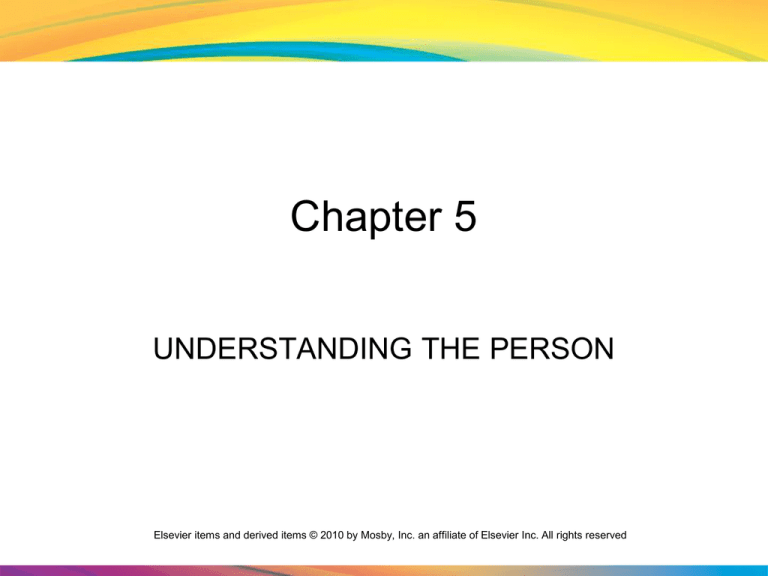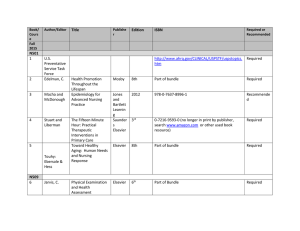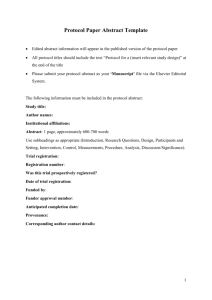
Chapter 5
UNDERSTANDING THE PERSON
Elsevier items and derived items © 2010 by Mosby, Inc. an affiliate of Elsevier Inc. All rights reserved
CARING FOR THE PERSON
• The patient or resident is the most important
person in the agency.
• Holism is a concept that considers the
whole person.
• The whole person has physical, social,
psychological, and spiritual parts.
– These parts are woven together and cannot be
separated.
– Each part relates to and depends on the others.
Elsevier items and derived items © 2010 by Mosby, Inc. an affiliate of Elsevier Inc. All rights reserved
2
• Follow these rules to address patients and
residents with dignity and respect:
– Use the person’s title.
• Mrs., Mr., Miss, Ms., or Dr.
– Do not use a first name unless the person asks
you to do so.
– Do not use any other name unless the person
asks you to do so.
– Do not call the person Grandma, Papa,
Sweetheart, Honey, or other name.
Elsevier items and derived items © 2010 by Mosby, Inc. an affiliate of Elsevier Inc. All rights reserved
3
BASIC NEEDS
• A need is something necessary or desired
for maintaining life and mental well-being.
Elsevier items and derived items © 2010 by Mosby, Inc. an affiliate of Elsevier Inc. All rights reserved
4
• According to psychologist Abraham Maslow:
– Basic needs must be met for a person to survive and
function.
– Needs are arranged in order of importance.
– Lower-level needs must be met before the higher-level
needs.
– Basic needs, from the lowest level to the highest level, are:
•
•
•
•
•
Physical needs
Safety and security needs
Love and belonging needs
Self-esteem needs
The need for self-actualization
Elsevier items and derived items © 2010 by Mosby, Inc. an affiliate of Elsevier Inc. All rights reserved
5
CULTURE AND RELIGION
• Culture is the characteristics of a group of people
passed from one generation to the next.
– People come from many cultures, races, and nationalities.
• Religion relates to spiritual beliefs, needs, and
practices.
– Many people find comfort and strength from religion during
illness.
• The care plan includes the person’s cultural and
religious practices.
Elsevier items and derived items © 2010 by Mosby, Inc. an affiliate of Elsevier Inc. All rights reserved
6
BEHAVIOR ISSUES
• A disability is any lost, absent, or impaired
physical or mental function.
– It may be temporary or permanent.
• Many patients, residents, and families
accept illness, injury, and disability.
– Those who do not adjust well have some of the
following behaviors:
Elsevier items and derived items © 2010 by Mosby, Inc. an affiliate of Elsevier Inc. All rights reserved
7
• Anger is a common emotion.
– Causes include:
•
•
•
•
Fear, pain, and dying and death
Loss of function and loss of control over health and life
Long waits for care or to see the doctor
A symptom of some diseases that affect thinking and
behavior
• Some people are generally angry
– Anger is shown verbally and nonverbally.
– Violent behaviors can occur.
Elsevier items and derived items © 2010 by Mosby, Inc. an affiliate of Elsevier Inc. All rights reserved
8
• Demanding behavior
– Nothing seems to please the person.
– The person is critical of others.
– Causes include:
•
•
•
•
Loss of independence
Loss of health
Loss of control
Unmet needs
Elsevier items and derived items © 2010 by Mosby, Inc. an affiliate of Elsevier Inc. All rights reserved
9
• Self-centered behavior
– The person cares only about his or her own needs.
– The needs of others are ignored.
• Aggressive behavior
– The person may swear, bite, hit, pinch, scratch, or kick.
– Causes include:
•
•
•
•
Fear
Anger
Pain
Dementia
– Protect the person, others, and yourself from harm.
Elsevier items and derived items © 2010 by Mosby, Inc. an affiliate of Elsevier Inc. All rights reserved
10
• Withdrawal
– The person has little or no contact with others.
• This may signal physical illness or depression.
• Some people are not social and like being alone.
• Inappropriate sexual behavior
– Behaviors include:
• Inappropriate sexual remarks
• Touching others
• Disrobing or masturbating in public
– The behaviors may be on purpose or due to
disease, confusion, dementia, or drug side
effects.
Elsevier items and derived items © 2010 by Mosby, Inc. an affiliate of Elsevier Inc. All rights reserved
11
• Some behaviors are not pleasant.
– You cannot avoid the person or lose control.
– To deal with behavior issues:
•
•
•
•
•
•
•
•
•
•
•
Recognize frustrating and frightening situations.
Treat the person with dignity and respect.
Answer questions clearly and thoroughly.
Keep the person informed.
Do not keep the person waiting.
Explain the reason for long waits.
Stay calm and professional, especially if the person is angry
or hostile.
Do not argue with the person.
Listen and use silence.
Protect yourself from violent behaviors.
Report the person’s behavior to the nurse.
Elsevier items and derived items © 2010 by Mosby, Inc. an affiliate of Elsevier Inc. All rights reserved
12
COMMUNICATING WITH THE
PERSON
• For effective communication between you
and the person, you must:
– Follow the rules of communication:
• Use words that have the same meaning for you and
the person.
• Avoid medical terms and words not familiar to the
person.
• Communicate in a logical and orderly manner.
• Give facts and be specific.
• Be brief and concise.
Elsevier items and derived items © 2010 by Mosby, Inc. an affiliate of Elsevier Inc. All rights reserved
13
– Understand and respect the patient or resident as a
person.
– View the person as a physical, psychological, social, and
spiritual human being.
– Appreciate the person’s problems and frustrations.
– Respect the person’s rights.
– Respect the person’s religion and culture.
– Give the person time to process the information that you
give.
– Repeat information as often as needed.
– Ask questions to see if the person understood you.
– Be patient.
– Include the person in conversations when others are
present.
Elsevier items and derived items © 2010 by Mosby, Inc. an affiliate of Elsevier Inc. All rights reserved
14
• Words are used in verbal communication.
– Follow these rules for the spoken word:
•
•
•
•
•
•
•
•
•
Face the person. Look directly at the person.
Position yourself at the person’s eye level.
Control the loudness and tone of your voice.
Speak clearly, slowly, and distinctly.
Do not use slang or vulgar words.
Repeat information as needed.
Ask one question at a time. Wait for an answer.
Do not shout, whisper, or mumble.
Be kind, courteous, and friendly.
Elsevier items and derived items © 2010 by Mosby, Inc. an affiliate of Elsevier Inc. All rights reserved
15
– Use the written word if the person cannot speak
or hear but can read.
• The nurse and care plan tell you how to communicate
with the person.
– When writing messages:
• Be brief and concise.
• Use a black felt pen on white paper.
• Print in large letters.
– Some persons cannot speak or read.
• Ask questions that have “yes” or “no” answers.
• Follow the care plan.
– Persons who are deaf may use sign language.
Elsevier items and derived items © 2010 by Mosby, Inc. an affiliate of Elsevier Inc. All rights reserved
16
• Nonverbal communication does not use
words.
– Gestures, facial expressions, posture, body
movements, touch, and smell send messages.
– Nonverbal messages more truly reflect a
person’s feelings than words do.
– Touch is a very important form of nonverbal
communication.
• The meaning depends on age, gender, experiences,
and culture.
• To use touch, follow the person’s care plan and
maintain professional boundaries.
Elsevier items and derived items © 2010 by Mosby, Inc. an affiliate of Elsevier Inc. All rights reserved
17
– People send messages through their body
language:
•
•
•
•
•
•
•
Facial expressions
Gestures
Posture
Hand and body movements
Gait
Eye contact
Appearance
– Control your body language as needed.
Elsevier items and derived items © 2010 by Mosby, Inc. an affiliate of Elsevier Inc. All rights reserved
18
• Communication methods
– Listening means to focus on verbal and
nonverbal communication.
• You use sight, hearing, touch, and smell.
– Direct questions focus on certain information.
– Open-ended questions lead or invite the person
to share thoughts, feelings, or ideas.
– You use clarifying to make sure that you
understand the message.
– Silence is a very powerful way to communicate.
• Sometimes you do not need to say anything.
Elsevier items and derived items © 2010 by Mosby, Inc. an affiliate of Elsevier Inc. All rights reserved
19
• Communication barriers prevent the sending
and receiving of messages.
–
–
–
–
–
–
–
–
–
Language
Cultural differences
Changing the subject
Giving opinions
Talking a lot when others are silent
Failure to listen
Pat answers
Illness and disability
Age
Elsevier items and derived items © 2010 by Mosby, Inc. an affiliate of Elsevier Inc. All rights reserved
20
PERSONS WITH SPECIAL NEEDS
• A person may acquire a disability any time
from birth through old age.
• Common courtesies and manners
(etiquette) apply to any person with a
disability.
• The person who is comatose:
– Comatose means being unable to respond to
verbal stimuli.
– The person who is comatose often can hear and
can feel touch and pain.
Elsevier items and derived items © 2010 by Mosby, Inc. an affiliate of Elsevier Inc. All rights reserved
21
– When caring for the person, do the following:
•
•
•
•
•
•
•
•
•
•
Assume that the person hears and understands you.
Use touch and give care gently.
Knock before entering the person’s room.
Tell the person your name, the time, and the place every time
you enter the room.
Give care on the same schedule every day.
Explain what you are going to do and explain care measures
step by step as you do them.
Tell the person when you are finishing care.
Use touch to communicate care, concern, and comfort.
Tell the person what time you will be back to check on him or
her.
Tell the person when you are leaving the room.
Elsevier items and derived items © 2010 by Mosby, Inc. an affiliate of Elsevier Inc. All rights reserved
22
FAMILY AND FRIENDS
• The presence or absence of family or friends affects
the person’s quality of life.
• The person has the right to visit with family and
friends in private and without unnecessary
interruptions.
– Protect the right to privacy.
– Treat family and friends with courtesy and respect.
– Provide support and understanding.
• Do not discuss the person’s condition with family
and friends.
– Refer their questions to the nurse.
Elsevier items and derived items © 2010 by Mosby, Inc. an affiliate of Elsevier Inc. All rights reserved
23




